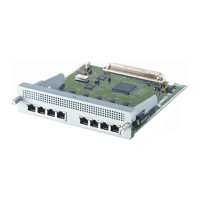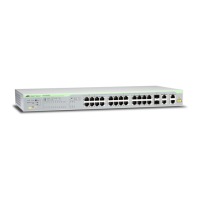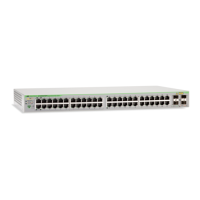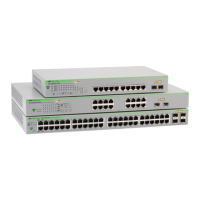User Event Logging Introduction
Software Reference for SwitchBlade x3100 Series Switches (Alarms and Troubleshooting)
8-32
Domain Name Control Message Type PP Interface SP Interface
Vid
---------------- ---------- ------------------ --------------- ------------
nc 4000 RingDownFlush 0.0 0.22
ga 4001 RingDownFlush 0.0 0.22
-----------------------------------------------------------------------------
8.8 User Event Logging
8.8.1 Introduction
Event Logs are logs that are enabled and disabled by the user in order to trace a series of events. The user
enables Event Logging for a specific application and is able to control what triggering events will generate logs.
This can be useful for user level debugging. The user also has the ability to control whether or not Event Logs
are sent to the CLI or just to the log buffer.
Note: Event Log settings do not persist over restarts.
8.8.2 Overview of Setup
Event Logs are stored in a buffer. All application logs share a common buffer. The size of this buffer can be set
by the user.
The order of commands to set up Event Logging is:
1. (Optional) User sets the log buffer size to store the logs. There is only one buffer for all logs. This buffer
always exists, but can be resized by the user. Resizing the buffer clears it of all current logs.
2. User sets up any application specific settings that control what triggering events will generate logs.
3. User enables application event logging. Event Logs now go into the buffer and to the CLI (optional).
The user has the ability to suspend and resume logging (using DISABLE LOG and ENABLE LOG commands)
without clearing the buffer. The buffer is only cleared with the CLEAR LOG command or when the Event Log
buffer is resized using the SET LOG BUFFERSIZE command).
Note: The user should take into consideration that event logging or tracing could affect system performance
during heavy network traffic periods.
The user can also offload the event logs using the PUT LOG FILE command.
8.8.3 Event Logging TRACE Commands
These commands add tracing parameters for Event Logging. The parameters, when specified together in a sin-
gle command, are taken to have a logical connection of “both.” Multiple invocations of this command have a log-
ical connection of “either.” If parameters are not specified, “all” is assumed.
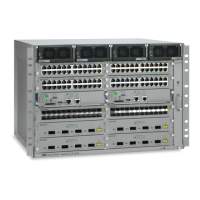
